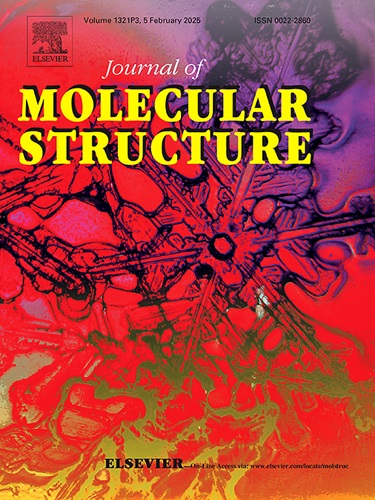Synthesis, DFT investigation, molecular docking, drug-likeness and molecular dynamic analysis of new quinoxaline-based pyrazoline derivatives
IF 4
2区 化学
Q2 CHEMISTRY, PHYSICAL
引用次数: 0
Abstract
A variety of quinoxaline-based pyrazoline derivatives were prepared by Suzuki–Miyaura cross-coupling reaction. Optimization for Suzuki coupling reaction was caried out and the best obtained conditions were using Pd(PPh3)4 as a catalyst, K2CO3 as the base, and 1,4 dioxane as the solvent at 120 °C for 10 h. High yields of newly synthesized compounds, ranging from 59% to 82%, have been achieved. Spectroscopic analyses, including NMR, FT-IR, and mass spectrometric methods, characterized and identified the synthesized derivatives. The results of this study will affect future changes to the structure of quinoxaline, which includes adding a pyrazoline moiety, and the therapeutic potential of pyrazoline derivatives derived from quinoxaline. The density functional theory (DFT/B3LYP) approach and the double zeta plus polarization basis set 6–31 G (d,p) for the C, H, N, and O atoms were used to investigate the optimal molecular geometries of the selected derivatives . In the docking study, the best ligand (ligand f) was selected based on drug-likeness evaluation and ADMET analysis. The results demonstrated that this ligand exhibits efficacy comparable to the standard drug, achieving a docking score of -7.3 kcal/mol against the 2az5 target. Furthermore, molecular dynamics simulations were conducted to assess the stability the ligand f. The analysis revealed that ligand f shows enhanced stability, suggesting its potential as a promising oral drug candidate targeting 2az5. The findings presented here are crucial for future structural alterations to quinoxaline-based pyrazoline derivatives and the utilization of quinoxaline derivatives' therapeutic potential as anticancer or antimicrobial drugs.

新的喹喔啉基吡唑啉衍生物的合成、DFT 研究、分子对接、药物相似性和分子动力学分析
采用Suzuki-Miyaura交叉偶联反应制备了多种喹诺啉基吡唑啉衍生物。对Suzuki偶联反应进行了优化,得到最佳反应条件为:以Pd(PPh3)4为催化剂,以K2CO3为碱,以1,4二氧六环为溶剂,在120℃下反应10 h,新合成的化合物收率在59% ~ 82%之间。光谱分析,包括NMR, FT-IR和质谱方法,表征和鉴定了合成的衍生物。本研究的结果将影响未来喹诺啉的结构变化,包括添加吡唑啉部分,以及喹诺啉衍生的吡唑啉衍生物的治疗潜力。利用密度泛函理论(DFT/B3LYP)方法和C、H、N、O原子的双zeta +极化基集6-31 G (d,p)对所选衍生物的最佳分子几何形状进行了研究。对接研究中,通过药物相似性评价和ADMET分析选择最佳配体(配体f)。结果表明,该配体具有与标准药物相当的功效,对2az5靶标的对接评分为-7.3 kcal/mol。此外,通过分子动力学模拟来评估配体f的稳定性。分析表明,配体f具有增强的稳定性,表明其作为靶向2az5的有前景的口服候选药物的潜力。本文提出的研究结果对未来喹诺啉基吡唑啉衍生物的结构改变以及喹诺啉衍生物作为抗癌或抗菌药物的治疗潜力的利用至关重要。
本文章由计算机程序翻译,如有差异,请以英文原文为准。
求助全文
约1分钟内获得全文
求助全文
来源期刊

Journal of Molecular Structure
化学-物理化学
CiteScore
7.10
自引率
15.80%
发文量
2384
审稿时长
45 days
期刊介绍:
The Journal of Molecular Structure is dedicated to the publication of full-length articles and review papers, providing important new structural information on all types of chemical species including:
• Stable and unstable molecules in all types of environments (vapour, molecular beam, liquid, solution, liquid crystal, solid state, matrix-isolated, surface-absorbed etc.)
• Chemical intermediates
• Molecules in excited states
• Biological molecules
• Polymers.
The methods used may include any combination of spectroscopic and non-spectroscopic techniques, for example:
• Infrared spectroscopy (mid, far, near)
• Raman spectroscopy and non-linear Raman methods (CARS, etc.)
• Electronic absorption spectroscopy
• Optical rotatory dispersion and circular dichroism
• Fluorescence and phosphorescence techniques
• Electron spectroscopies (PES, XPS), EXAFS, etc.
• Microwave spectroscopy
• Electron diffraction
• NMR and ESR spectroscopies
• Mössbauer spectroscopy
• X-ray crystallography
• Charge Density Analyses
• Computational Studies (supplementing experimental methods)
We encourage publications combining theoretical and experimental approaches. The structural insights gained by the studies should be correlated with the properties, activity and/ or reactivity of the molecule under investigation and the relevance of this molecule and its implications should be discussed.
 求助内容:
求助内容: 应助结果提醒方式:
应助结果提醒方式:


